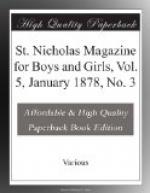And when I, listening, heard a chirp,
Another, and another,
I
knew as well
As
words could tell
They’d found the old grandmother!
WHERE MONEY IS MADE.
BY M.W.
“Ho!” I hear some New York boys say; “no need to tell us that. Everybody knows that New York is the place to make money. Look at the men in Wall street.”
Indeed! And what will you say if I tell you that there is not a dollar of money made in New York; nor in Chicago, neither; though I know my young friends who live there are eager to speak up and claim the honor. There are but three cities in all the Union where money is actually made; that is, where metals are coined. The principal mint of the United States is in Philadelphia. Here are made all the copper and nickel coins—one, two and five cent pieces—and a large part of the gold and silver coins used in the country. There are also branch mints at San Francisco and Carson City. And at these places gold and silver coins of every value are coined in great quantities.
Those of you who have been in Philadelphia will remember, on the north side of Chestnut street, near Broad, a Grecian building of white marble, somewhat gray from age, with a tall chimney rising from the center, and the United States flag flying from the roof. This is the mint. Let us climb the long flight of steps and enter the building. On the door is a placard: “Visitors admitted from 9 to 12.” The door opens into a circular entrance hall, with seats around the wall. In a moment a polite usher, who has grown gray in the service of the institution, comes to show us all that visitors are allowed to see. He leads us through a hall into an open court-yard in the middle of the building. On the left is the weighing-room; and if you owned a gold mine, like the boy I read of in a late number of ST. NICHOLAS, it is to this room you would bring your gold to be weighed, so that you might know how much money the mint must pay you for it. All the gold and silver received in the mint is weighed in this room. Sometimes the gold is brought in the form of fine dust; sometimes in the shape of grains from the size of a pin’s head to that of a pea; sometimes in plates and bars, and sometimes it is old jewelry and table service. Visitors are not allowed to enter the weighing-room; but, by looking through the window you can see the scales, large and small, which are balanced with wonderful delicacy, and the vault on the other side, where the treasure is kept.
[Illustration: THE MINT AT PHILADELPHIA.]
“When the gold has been weighed,” says our guide, “it is locked up in iron boxes, and carried to the melting-room, where it is melted and poured into molds.”
A small piece is then cut off, and its fineness ascertained by a long and delicate process called assaying. This decides the value of the lot. The depositor is then paid, and the metal is handed over to the melter and refiner, to be entirely freed from its impurities and made fit for coinage.




